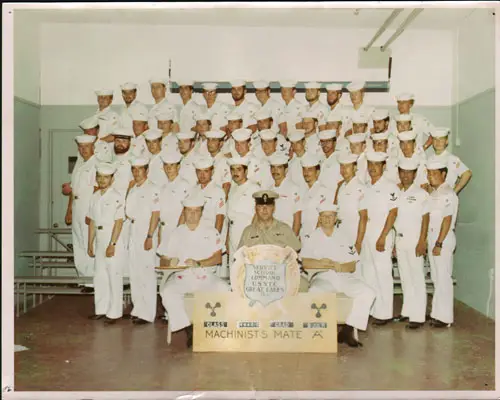NTC Great Lakes SSC Company 71-4445-D Group Photo
Group Photograph of Class 4445-D Machinist's Mate "A" School, Great Lakes Naval Training Center, Graduated 9 July 1971. Photograph Courtesy of James M. Kelly and the Irvington, Virginia Post Office.
Provenance of the Photograph
The group photograph was found at the Irvington, Virginia Post Office several years ago (circa 2007). It had been placed in the Lost and Found Bulletin Board at the Post Office where it remained until November 2009, when it was forwarded to the Gjenvick-Gjønvik Archives for safekeeping.
You may claim this photograph by offering specifics as to the actual date (Month and Year) that you misplaced the photograph as well as where it was likely found. Please contact the Gjenvick-Gjønvik Archives at if you have any information or can identify members of Class 4445-D Machinist's Mate "A" School.
The Role and Trining of a Machinist's Mate
According to the Bureau of Naval Personnel (BUPERS), the job of an MM is to "operate, maintain, and repair (organizational and intermediate level) ship propulsion machinery, auxiliary equipment, and outside machinery, such as: steering engine, hoisting machinery, food preparation equipment, refrigeration and air conditioning equipment, windlasses, elevators, and laundry equipment.
Operate and maintain (organizational and Intermediate level) marine boilers, pumps, forced draft blowers, and heat exchangers; perform tests, transfers, and inventory of lubricating oils, fuels, and water. Maintain records and reports, and may perform duties in the generation and stowage of industrial gases."
Enlistees are taught the fundamentals of this rating through on-the-job training or formal Navy schooling. Advanced technical and operational training is available in this rating during later stages of career development. -- NAVPERS 18068F
Machinist's Mates (Submarine) and Machinist's Mate (Surface) generally fall into one of three roles:
Propulsion Mechanics
The core job of an MM is the engine room. A mechanic's job in the engine room is to operate the steam plant that provides propulsion, electric power (along with Electrician's Mates), potable water, and service steam to the ship. MMs operate the boilers that generate the steam (this job was previously done by Boiler Technicians, but the BT rating merged with Machinist's Mates in 2000) and use it to operate main engine (propulsion turbines), turbo generators, distilling units, and various auxiliary turbines. MM's working in the propulsion plants are often referred to as Pit Snipes, or Snipes for short.
Machinist's Mates responsible for the propulsion plant are found in Machinery Division (or Main Engine Division, Main Propulsion Division, etc.. in some ships), commonly referred to simply as M-Division or MP-Division. On surface nuclear ships, propulsion mechanics are found in Reactor Propulsion Division (commonly still referred to as M-Div), Reactor Mechanical Division (RM), Reactor Laboratories Division (RL). The USS Enterprise is the exception, in that M-Division is still part of Engineering Department, as opposed to Reactor Department.
Auxiliary Mechanics
The other major place to find Machinist's Mates is in the Auxiliaries Division of Engineering Department, often referred to as "A-gang". Mechanics in this role establish training & work on mechanical equipment within and outside of the engine rooms.
To include the operation and preventive maintenance of: AC&R (Air Conditioning and Refrigeration) units, O2/N2 (liquid oxygen and nitrogen) units, hydraulic lifting and hoisting gear, hydraulic power plant components and mechanisms, chilled and fresh water, atmoshere control, ventilation, emergency diesel and corresponding sub-systemes, ballast control, auxiliary drain, compressed air and gases, plumbing, trash disposal & other equipment as designated by the Engineering Officer (Chief Engineer, or CHENG).
Members of "A-Gang" may also help DC Men, Gunner's Mates, or other ratings. Some listed attributes apply to submarine warfare to include SUBSAFE requirements for work authorization. All systems listed apply to a minimum of valve, pump maitenance repair.
Nuclear Mechanics
Some MMs are qualified to work on nuclear propulsion plants. They are designated as MMN (Machinist's Mate Nuclear), though the N is generally only used for the purposes of billeting and advancement exams. These mechanics go through a rigorous training program consisting of three months at the Nuclear Field "A" School, six months of Naval Nuclear Power School, and six months at one of four Nuclear Power Training Units (prototypes).
Two NPTUs are moored training ships (MTS) using S5W reactors located at the Naval Weapons Station in Charleston, South Carolina, and two additional NPTUs are surface prototype units using an S5W reactor and an S8G reactor located in Ballston Spa, New York. This course of instruction is commonly referred to as "the nuclear-power pipeline."
MMNs earn a 3385 NEC (surface) or 3355 (submarines) upon completion of prototype. Along with the normal duties of a propulsion mechanic, they are responsible for the operation, maintenance, and repair of the auxiliary equipment in support of the naval reactors under their care. Later in his career, the MMN will qualify his/her Senior In-Rate watchstation (Chief Reactor Watch for surface MMNs in Reactor Mechanical division, Chief Machinery Operator for those in Machinery Division, and Engine Room Supervisor for submariners) and receive the supervisory NEC of 3395 or 3365 as appropriate.
Engineering Laboratory Technicians
Additionally, some MMNs are designated as Engineering Laboratory Technicians (NEC 3386 for surface, 3356 for submariners) following successful completion of an additional 13 weeks of training. ELTs are water chemistry and radiological controls experts for their commands. Upon qualification of one of the above-mentioned Senior In-Rate watches, they are awarded NECs 3396 or 3366.
Submarine Nuclear Propulsion Plant Emergency Welders
Also, on submarines, some MMNs are designated as Submarine Nuclear Propulsion Plant Emergency Welders (NEC 3351). They go through a two month school learning welding, brazing, and soldering from Hull Maintenance Technician senior enlisted welders. Each submarine is required to have at least one of them to go underway. They are on board to provide emergency repairs to the reactor plant if necessary to get the ship back to port where professional welders can complete a certified repair.

